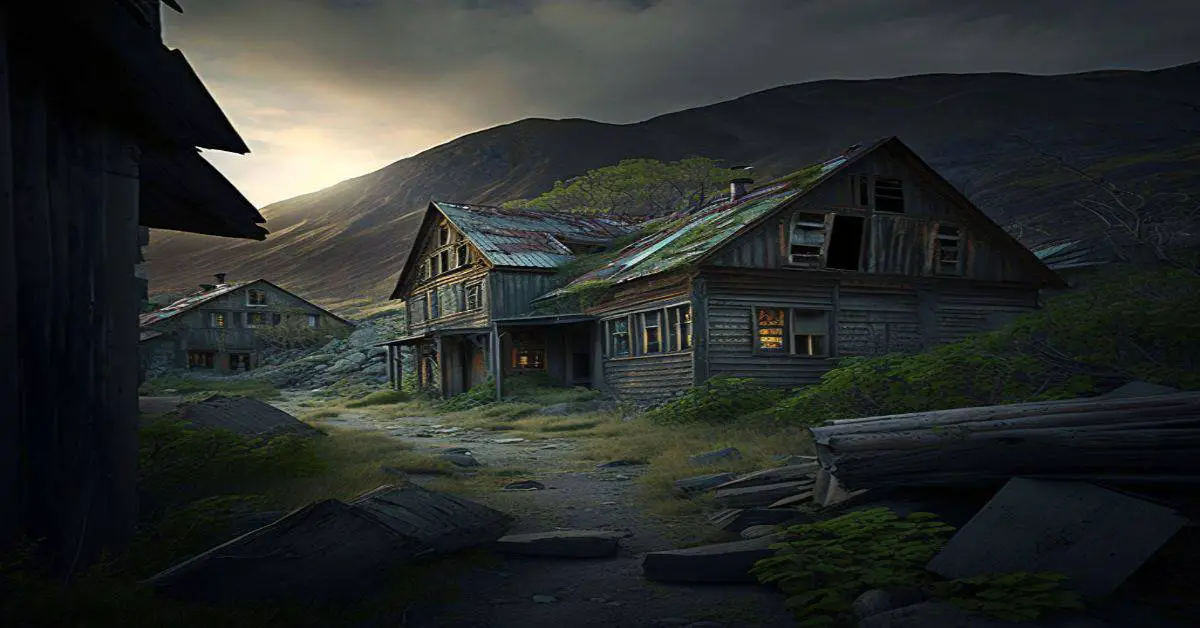You’ll discover Marlborough’s fascinating ruins in Lake County, Michigan, where a pioneering cement company town thrived from 1902 to 1910. At its peak, this progressive community of 400 residents boasted 72 buildings, including an opera house and the world’s largest cement plant. Though the Great Northern Portland Cement Company’s bankruptcy led to the town’s abandonment, Marlborough’s concrete remnants and documented legacy offer compelling insights into early 20th-century industrial innovation.
Key Takeaways
- Marlborough was a thriving company town established in 1902 around the world’s largest cement plant in Lake County, Michigan.
- The town peaked at 400 residents with 72 buildings including homes, an opera house, school, and hotel with modern amenities.
- Economic collapse occurred in 1910 when the cement company went bankrupt, unable to compete with modern limestone-based production methods.
- After the factory’s closure, the town was abandoned and dismantled, leaving only concrete ruins and scattered remnants.
- The site gained historic recognition, listed on the National Register of Historic Places in 1972 and remains explorable today.
The Birth of a Cement Empire
While Michigan’s industrial landscape was rapidly evolving in the 1890s, the Great Northern Portland Cement Company established what would become one of the state’s most ambitious manufacturing ventures near a marl-rich lake in Lake County.
The community boasted 72 buildings, including an opera house, school, post office, and an impressive 88-room hotel.
To support this massive operation, the company built what became the largest power plant in Michigan’s Lower Peninsula.
You’ll find the cement industry’s influence reflected in every aspect of the operation, from the six kilns and fourteen grinding mills to the pioneering use of reinforced concrete throughout the facility.
The factory complex represented cutting-edge industrial design, utilizing marl deposits left by receding glaciers to produce cement in what was then the most extensive operation of its kind in the region.
The company town of Marlborough, named by combining “marl” and “borough,” emerged in 1902 to support this industrial vision. Within three years, the community dynamics transformed as the population swelled to 400 residents.
Industrial Innovations and Engineering Feats
When Great Northern Portland Cement constructed its massive facility in 1902, the company embraced groundbreaking technological innovations that would reshape Michigan’s industrial landscape.
You’ll find that the plant’s most significant engineering advancement was its pioneering use of Julius Kahn’s revolutionary reinforced concrete system, which transformed industrial architecture across America.
The facility’s impressive engineering feats included fourteen grinding mills and six kilns spread across 80 acres, processing marl from North Lake into cement.
This immense operation was a testament to industrial progress, becoming the world’s largest cement plant at its time of construction.
You’d marvel at the site’s massive infrastructure: a warehouse stretching hundreds of feet, an integrated rail system, and the Lower Peninsula’s largest power plant.
The factory’s daily output reached seven railroad cars of finished cement, demonstrating the remarkable scale of this operation that pushed the boundaries of early 20th-century industrial capabilities.
The company’s stock worth $1 million at incorporation in 1901 reflected investors’ confidence in this ambitious industrial venture.
Life in the Bustling Company Town
Beyond the plant’s technical marvels, Marlborough emerged as a vibrant community of 400 residents by 1905.
After work, you’d return to one of 72 homes ranging up to stately quality, with modern amenities like streetlights illuminating your path.
Community events flourished at the opera house, where you could enjoy entertainment with neighbors.
Factory workers used the Victor steam shovel to extract clay from the riverbank during their shifts.
The 88-room hotel buzzed with visitors, while local stores provided necessities.
Your children would attend the town school, and you’d collect mail at the post office, maintaining connections beyond the company town’s borders.
This self-contained world offered everything needed for a fulfilling life – until the plant’s bankruptcy in 1906.
Your daily routines would have centered around the cement plant’s demanding work schedule, operating kilns and grinding mills while producing seven railroad cars of cement daily.
Social Progress and Community Growth
Despite its brief existence, Marlborough emerged as a remarkably progressive community for its era, offering unprecedented opportunities for diverse populations.
You’ll find evidence of cultural integration in the town’s unique real estate policies, which allowed Black Americans to purchase property when such opportunities were scarce elsewhere in the country.
The town’s immigrant contributions shaped its social fabric, as workers from various regions brought their traditions and customs to this industrial hub. The Marlborough Cornet Band regularly entertained residents, bringing music and celebration to the community.
You’d have witnessed this diversity reflected in the community’s vibrant social spaces, including an opera house and an 88-room boardinghouse.
The establishment of essential services like schools, street lighting, and a post office demonstrated Marlborough’s commitment to creating an inclusive, modern society where different cultures could thrive together.
The Path to Economic Collapse
As Marlborough entered the twentieth century, its economic foundation rested precariously on the Great Northern Portland Cement Company’s operations.
The population reached its peak of over 400 residents in 1902, marking the height of the town’s prosperity.
You’ll find that the company’s economic vulnerability became apparent through its inability to adapt to changing industry standards and technological innovations.
While competitors embraced new limestone-based manufacturing processes, Marlborough’s plant clung to outdated marl-processing methods that proved increasingly costly and inefficient.
The factory’s desperate attempts to maintain profitability by potentially using inferior materials only hastened its decline.
Despite constructing Michigan’s largest power plant, you can trace the company’s downfall to its failure in technological adaptation.
By 1910, the company faced complete bankruptcy and closure, leading to the dismantling of both factory and town.
Remnants and Ruins Today
Today, sprawling across 80 acres of forested terrain, the industrial ruins of Marlborough stand as silent sentinels to Michigan’s cement-manufacturing past.
You’ll find an impressive collection of concrete remnants from the Great Northern Portland Cement Company, including service tunnels, kilns, and storage units – perfect subjects for ghost town photography enthusiasts.
The site has remained abandoned since 1907, leaving nature to slowly reclaim the industrial landscape.
For ruin exploration adventurers, these historic structures offer:
- Massive concrete walls being reclaimed by persistent forest growth
- Exposed steel reinforcing rods showcasing early Kahn System construction
- A maze-like network of industrial foundations and scattered rubble
- Weathered surfaces adorned with graffiti and wild vegetation
While the 72 houses and community buildings have vanished, the industrial ruins persist, designated as a Michigan State Historic Site in 1971, though they continue to decay naturally with each passing season.
Historic Preservation Efforts
You’ll find that Marlborough’s historical significance gained official recognition when it was designated as a Michigan State Historic Site in 1971, protecting the cement plant ruins and town remnants from destruction.
The Lake County Historical Society has taken a leading role in preserving Marlborough’s legacy through various initiatives, including their 2022 documentary “Marlborough, A Tale of Riches to Ruins.”
Their extensive documentation efforts encompass collecting historical photographs, archival materials, and oral histories while facilitating educational tours that keep the ghost town’s industrial heritage alive for future generations.
National Historic Place Status
The historical significance of Marlborough’s industrial legacy earned the site prominent recognition through its designation as a Michigan State Historic Site in 1971 and subsequent listing on the National Register of Historic Places in 1972.
The 80-acre district in Pleasant Plains Township preserves essential elements of Michigan’s industrial heritage, though preservation challenges persist due to natural forest reclamation and structural deterioration.
You’ll find these remarkable features within the protected historic district:
- Reinforced concrete ruins of the world’s largest Portland cement factory
- Multiple cement kilns and intricate service tunnel networks
- Foundations of a once-thriving community, including an 88-room hotel
- Remnants of public buildings like the opera house, school, and post office
The site’s protected status helps maintain this invaluable record of early 20th-century industrial development while safeguarding its cultural legacy.
Community Documentation Initiatives
Since abandonment in the early 1900s, extensive documentation initiatives have preserved Marlborough’s cultural legacy through multiple channels of historical research and community engagement.
You’ll find thorough records maintained by the Lake County Historical Society, including detailed accounts of the town’s 72 houses and community buildings.
The collection of oral histories from descendants and local historians has enriched the archival collections, which feature demolition records, photographs, and technical documentation of the innovative cement plant.
Today’s visitors frequently document the overgrown ruins that nature has steadily reclaimed over the decades.
You can explore these materials through various platforms, from scholarly publications to social media.
The Historical Society’s collaboration with preservationists guarantees accurate interpretation of the ruins, while their educational programs and guided tours help you connect with this fascinating piece of Michigan’s industrial heritage.
Legacy of Michigan’s Lost City
Although Marlborough’s glory days were short-lived, its legacy endures through scattered concrete ruins and architectural innovations that helped shape Michigan’s industrial heritage.
Today, urban exploration enthusiasts can discover an 80-acre monument to early 20th-century industrial ambition, where Julius Kahn’s pioneering concrete structures still stand as silent guardians of cultural heritage.
- Massive cement kilns pierce the landscape, their weathered forms telling stories of technological transformation.
- A mysterious service tunnel winds beneath the surface, inviting exploration of the town’s industrial underbelly.
- Labyrinthine concrete walls, now canvas for graffiti artists, showcase early reinforced concrete engineering.
- The sprawling storage facility’s remains hint at Marlborough’s once-mighty cement production capabilities.
You’ll find these ruins serve as both historical markers and stark reminders of how quickly fortunes can change in single-industry towns.
Frequently Asked Questions
Are There Any Documented Accidents or Deaths at the Cement Factory?
Though you’d expect factory hazards given the era’s limited worker safety standards, there’s no documented evidence of accidents or deaths at this cement factory in available historical records or archives.
What Happened to the Residents After the Town’s Collapse?
You’ll find that residents’ migration scattered workers to nearby Lake County towns seeking fresh employment, while their abandoned hometown’s legacy persists through historical site designation and preserved ruins.
Can Visitors Take Guided Tours of the Marlborough Ruins Today?
You can’t take guided experiences of these historically significant ruins today, as they’re located on private property where trespassing is prohibited. You’ll need to view remaining structures from public roads only.
Did Any Original Marlborough Buildings Survive and Get Relocated Elsewhere?
Like ghosts fading into mist, you won’t find any transplanted original structures from this site elsewhere. Historical records show buildings were demolished or salvaged for materials rather than relocated intact.
Were There Any Attempts to Revive the Town After 1910?
You won’t find evidence of any successful revival efforts after 1910. The dismantled infrastructure, salvaged buildings, and technological obsolescence of marl-based cement prevented meaningful community impact or industrial restoration.
References
- https://99wfmk.com/2018marlboroughruins2018/
- https://www.nailhed.com/2014/02/roman-ruins-on-forest-moon-of-endor.html
- https://lostinmichigan.net/concrete-ghost-town/
- https://freshwater-reporter.com/new-documentary-cements-marlboroughs-boom-to-bust-history/
- https://www.bigrapidsnews.com/local-news/article/Ghost-town-Exploring-the-abandoned-ruin-of-14153870.php
- https://en.wikipedia.org/wiki/Marlborough_Historic_District
- https://www.bigrapidsnews.com/news/article/michigan-ghost-towns-6-year-history-marlborough-18277390.php
- https://www.mininggazette.com/news/2023/07/invention-and-innovation-bring-changes-to-society/
- https://www.lmtonline.com/local-news/article/Ghost-town-Exploring-the-abandoned-ruin-of-14153870.php
- https://www.pinterest.com/pin/marlborough-ghost-town–146578162846079324/


